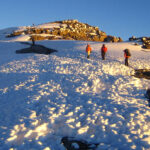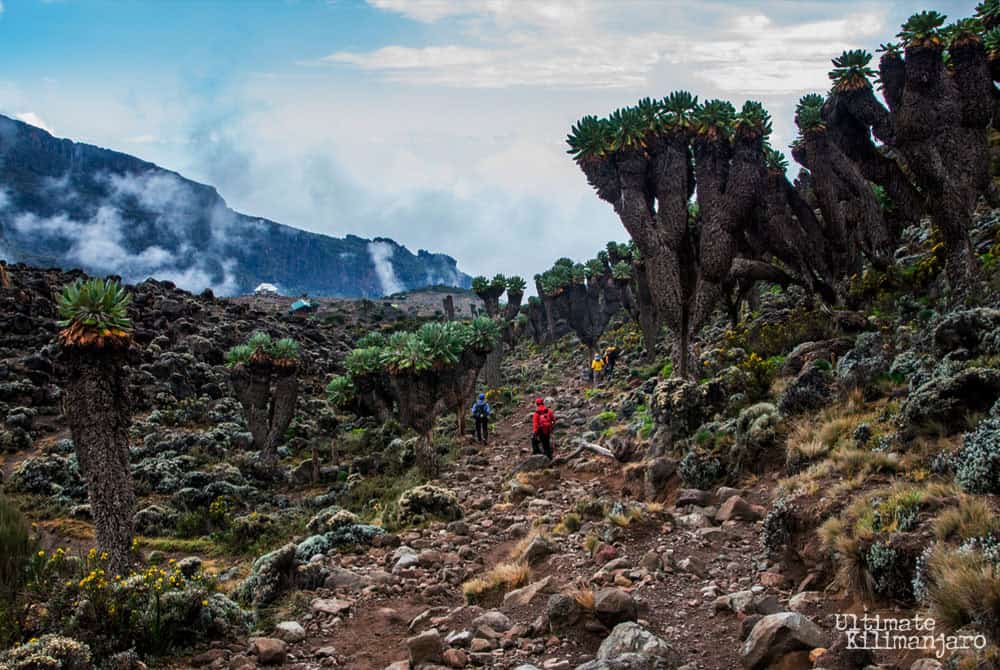Why Climb Kilimanjaro in 2025
The world’s highest free-standing mountain (5,895 m / 19,341 ft) remains a life-list classic—reachable without technical mountaineering, yet demanding enough to be transformational. In 2025, three trends make Kili especially compelling:
- Smarter itineraries & higher summit odds. More outfitters emphasize longer itineraries (7–8+ days) and camp profiles that “climb high, sleep low,” which correlates with better success than short, rush routes.
- Improved safety ecosystem. The Kilimanjaro corridor now has better emergency protocols, more operators carrying pulse oximeters, oxygen, and portable hyperbaric bags, plus established helicopter/evac options when medically indicated. Mandatory briefings and guide certification have tightened, improving risk management. (Evac by helicopter remains rare but available with proper insurance.
- Eco-conscious guiding. Operators increasingly follow Leave No Trace, invest in porter welfare, and support waste-management initiatives on high-use routes—part of a broader push toward responsible tourism. (Route selection also helps: longer, less-trafficked itineraries spread impact.)
- Best 2025 windows: January–mid-March and June–October offer the steadiest conditions for most trekkers. Shoulder weeks can be quieter but wetter.
Kilimanjaro Routes Compared
At a glance: All routes require a licensed guide team. Longer itineraries raise acclimatization—and success—odds. “Difficulty” here reflects steepness, day length, and acclimatization profile, not technical climbing.
Route | Scenery | Difficulty | Typical Duration | Notes / Who It Suits |
Machame | Lush rainforest → moorland → Barranco Wall → alpine desert | Moderate–Hard | 7 days (6 possible) | Very popular, very scenic; good acclimatization if 7 days. |
Lemosho | Remote start, panoramic Shira Plateau, converges near Barranco | Moderate | 8 days (7 possible) | Arguably the most beautiful; excellent acclimatization over 8 days. |
Rongai | Drier north-side forest, views of Mawenzi | Moderate | 6–7 days | Less crowded; good in wetter months; gentler gradients. |
Umbwe | Direct, steep ridge | Hard | 6 days | Shortest/steepest—poor acclimatization; for experienced trekkers only. |
Shira | Accesses Shira Plateau via higher drive start | Moderate–Hard | 7 days | Similar finale to Lemosho; higher start can challenge acclimatization on Day 1–2. |
Marangu | Rainforest → moorland → The Saddle → Kibo | Moderate (walking only) | 6 days (5 possible) | Only hut route; shorter profile = historically lower success if done in 5 days; add the 6th day to improve odds. |
Success rates & duration: Operators report markedly higher summit success on 7–8 day versions (Lemosho, 7-day Machame, 6-day+ Marangu with extra acclimatization day) vs. 5-day rushes. Treat any published “overall” rate cautiously—odds vary by route length and operator protocols.
Climber Preparation & Training
Fitness focus (8–12 weeks out):
- 3 cardio sessions/week (hills, intervals, stair climbs). Build to 1 long hike (4–8 hrs) weekly with a daypack.
- 2 strength sessions/week: posterior chain (glutes/hamstrings), quads, calves, core; add loaded step-ups.
- Practice back-to-back hiking days and poles use; simulate summit-day pacing (slow, steady, “pole pole”).
Personal gear checklist (high-level):
- Footwear: broken-in waterproof boots; camp shoes.
- Layers: moisture-wicking base, fleece/mid, synthetic or down puffy, waterproof hard shell (jacket & pants).
- Sleep: 4-season bag (-10 to -15 °C comfort), liner; quality pad.
- Accessories: warm hat/balaclava, sun hat, liner + insulated gloves, neck gaiter, UV sunglasses.
- Hydration & health: 2–3 L capacity (bottles + insulated cover and/or bladder), electrolytes, personal meds, blister kit, earplugs.
- Tech & misc.: headlamp + spare batteries, power bank, dry bags, trekking poles, toiletries, small towel, passport copies, cash for tips.
Altitude Acclimatization & Health
- Go slow, add days. Seven days is a practical minimum for most trekkers; 8–9 days further improves acclimatization. Expect daily SpO₂/pulse checks with a good operator.
- Hydrate, fuel, rest. 3–4 L fluids/day, electrolytes, steady carbs, and sleep hygiene help mitigate Acute Mountain Sickness (AMS).
- “Climb high, sleep low.” Many itineraries include a high point (e.g., Lava Tower) before descending to camp—an intentional stress-and-recover dose for your body.
- Med guidance. Discuss acetazolamide prophylaxis and personal risk factors with a travel clinician; know AMS/HACE/HAPE red flags and the plan: descend, oxygen, evacuation if needed. The CDC’s Yellow Book has up-to-date guidance for high-altitude trekking and East Africa travel health.
- Rescue reality. Helicopter evacuations exist with suitable weather/landing zones and correct insurance—but prevention (pacing, extra days) remains the best “rescue.”
Departure Logistics: Arusha/Moshi → Summit
Arrival & staging
- Fly into JRO (Kilimanjaro International). Transfers to Moshi (~1 hr) or Arusha (~1.5–2 hrs) are straightforward; most climbs stage from these towns the day before park entry.
- Gear check & briefings the afternoon prior; last-minute rentals arranged in town.
- Park fees & permits are handled by your operator; fees are set by TANAPA/Kilimanjaro National Park and updated periodically (budget for entrance, campsite/hut, rescue, conservation fees, VAT).
A typical summit-day (Barafu/Kibo to Uhuru Peak)
- 00:00–01:00 Wake, tea/snack, final gear check.
- 00:30–01:30 Depart by headlamp; slow, metronomic pace on scree.
- ~05:00–06:30 Stella Point (via southern routes) or Gilman’s Point (via Marangu/Rongai); quick refuel.
- ~06:30–08:00 Traverse crater rim to Uhuru Peak (5,895 m)—sunrise if timed well.
- Short summit stay (wind chill is brutal), then descend to high camp for brunch and continue lower (e.g., Mweka or Horombo) to sleep at safer altitude.
Why Choose Takwenya Safaris
- Expert, mountain-first leadership. Veteran head guides with wilderness medical training, daily health monitoring, and conservative call-making.
- High success through smart itineraries. Takwenya favors 7–8 day profiles (Lemosho, Machame, Rongai) with purposeful “climb-high, sleep-low” exposures to boost acclimatization. (This approach aligns with industry data linking longer itineraries to better outcomes.)
- Responsible tourism at heart. Fair porter policies, Leave No Trace practices, and support for local supply chains—because great summits shouldn’t come at the environment’s or community’s expense.
- End-to-end ease. Airport pickups, quality rentals, thorough briefings, and seamless transitions to post-climb safaris in the Northern Circuit parks.
Ask Takwenya for: current gear list, exact medical kit (oxygen/hyperbaric availability), evacuation insurance requirements, and a recommended 7–8 day route based on your hiking background and season.

